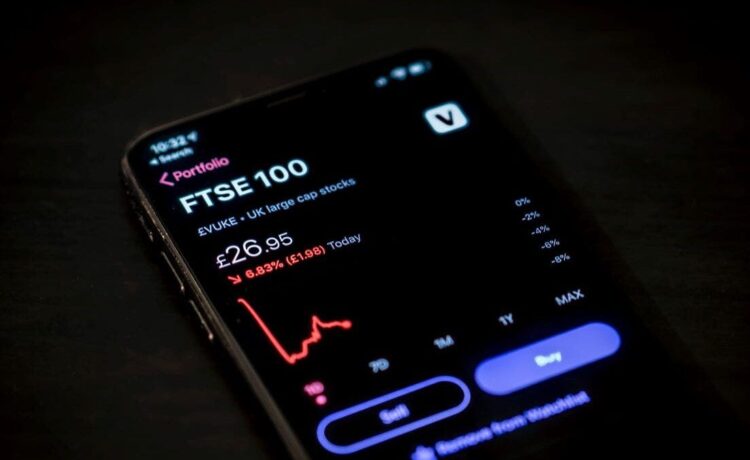Table of Contents
Show more
Show less
The FTSE 100 is a stock market index made up of the largest 100 companies listed on the London Stock Exchange.
It’s one of the world’s most famous stock market indices, acting as a barometer of how the UK market is performing. Here’s how the FTSE 100 works, and how to invest in it.
What is a stock market index?
A stock market index provides a way to track changes in the price of a ‘basket’ of shares.
This allows investors to see how a particular stock market performs over time, and to gauge how different markets compare with one another.
Indices also enable investors to see how a particular company’s shares are performing against, say, a peer group – or sector – of similar businesses.
Most indices, including the FTSE 100, are weighted by company size. This means larger companies have a proportionally larger impact on its overall performance.
Company size is usually measured by market capitalisation, or ‘cap,’ which is calculated by multiplying a company’s share price by the total number of shares in circulation.
A company with a market cap of £10 billion has double the weighting of a company worth £5 billion, for example.
Once each company within an index has been weighted, the combined market cap of all their shares is calculated on a daily basis. This enables a valuation of the overall index to be made and allows investors to see how its performance changes, both up and down, over time.
Indices provide a snapshot of the performance of a market and are an important tool for assessing investment performance, acting as a benchmark that actively managed investment funds can attempt to outperform.
What is the FTSE 100?
The UK’s best-known index is the Financial Times Stock Exchange (FTSE) 100. This index is made up of the 100 largest companies listed on the main market of the London Stock Exchange by market cap. The index is commonly referred to as the ‘Footsie’.
FTSE 100 price
The graph below displays the past performance of the FTSE 100 index. Past performance is not a reliable indicator of future results.
At the time of writing (August 2025), the pharmaceuticals giant AstraZeneca is the largest company in the FTSE 100, with a market cap of about £187 billion. At the other end of the list is investment platform provider IG Group, valued at £4 billion.
Financial firms including banks such as Lloyds, HSBC, and NatWest are a mainstay of the index, along with energy companies such as Shell and BP, mining businesses (Rio Tinto) and makers of everyday consumer goods (such as Unilever). You can find a full list of FTSE 100 constituents here.
How to invest in the FTSE 100
Investors looking for exposure to the FTSE 100 have two main options – purchasing shares in one or more of the companies that make up the index, or investing in an index tracker fund.
These funds aim to replicate the performance of a particular stock market index by investing in some, or all, of its constituent companies.
Pro Tip
Stamp Duty Reserve Tax is payable on the purchase of UK shares, calculated at 0.5% of the value of the transaction. This is not usually charged on buying overseas shares, although other taxes may be charged
There are two main types of tracker funds:
- Open-ended investment companies (OEICs): these either track the index directly or may invest in a subset of the index, for example, UK large-cap shares. They are priced once per day, and investors won’t know the execution price until after the trade is complete
- Exchange-traded funds (ETFs): like OIECs, these aim to replicate an index, but they have a ‘live’ price, meaning investors know the execution price when they place the trade.
There are two methods used by tracker funds to replicate an index. The first is ‘full replication’, where the fund buys shares in each of the companies in the FTSE 100 index, say, in proportion to its weighting.
Alternatively, ‘partial replication’ is when the fund holds a representative sample of companies to replicate the index, rather than every company on it. It is typically used when there is a high number of companies in an index, or where some shares are ‘illiquid’ (when it’s harder to buy and sell them).
The average annual management fee for a tracker fund is around 0.05% to 0.20%, compared to 0.5% to 1.0% for an actively-managed fund, where stocks are picked on their perceived merits and prospects. Using the lower of each pair of figures, this means that a £1,000 investment in a tracker would typically cost £5, compared with £50 for an active fund.
Tracker funds can also be bought within a tax-efficient wrapper such as an Individual Savings Account (ISA) or Self-Invested Personal Pension (SIPP), which are free from capital gains and income tax.
Tax treatment depends on one’s individual circumstances and may be subject to future change. The content of this article is provided for information purposes only and is not intended to be, nor does it constitute, any form of tax advice.
Buying FTSE 100 shares and funds
Once an investor has made up their mind about which funds or shares to purchase, they can work through the following steps:
1) Open an account with an investing platform
Investing platforms allow individuals to buy, hold and sell investments.
To open an account, inventors will need to provide basic information – such as their full name, date of birth and address – before funding the account.
2) Carry out research
Before committing to a stock or fund, it’s important to do some research.
When it comes to researching an individual company, the ‘investor relations’ page of its website is a good place to start. Here, would-be investors can find financial results and news.
Each investment fund and ETF should come with a factsheet outlining past performance, strategy and major holdings.
Most investing platforms also provide their own research, allowing customers to gain insight into the shares and funds they’re considering.
3) Choose an investment strategy
Individuals typically invest in one of two ways: with a lump sum, or with smaller regular instalments.
Investing little and often also allows investors to get started right away, regardless of whether they have a lump sum saved. Since share prices rise and fall over time, regular investing also means that, overall, investors pay the market average price for their shares.
On the other hand, regular investing usually comes with regular trading fees. A lump sum investment may also achieve greater growth, as investors benefit from the effects of compounding.
4) Place an order
The quickest way to buy shares and funds is usually online, or through an app.
Customers can find their chosen asset using a search bar, before selecting how much they’d like to invest.
5) Keep an eye on performance
Investors should assess their portfolio’s performance on a regular basis. Depending on the type of investments held – and individual preference – this check could be annual, quarterly, monthly or even more frequently.
This is a good opportunity to decide if any adjustments are needed. For instance, if a particular investment is consistently underperforming, it could make sense to sell.
How does the FTSE 100 index work?
The FTSE 100 index is maintained by FTSE Russell, and reviewed every quarter. During each review, companies may enter or leave the index, depending on their recent performance and market cap.
Companies tend to benefit from a boost to their share price if they are promoted to the FTSE 100, since tracker funds are obligated to buy shares to replicate changes to the index.
The reverse is also true, with companies facing further downward pressure on their share price if they are moved to a lower index. These companies may enter the FTSE 250, which comprises the next 250 largest companies after the FTSE 100.
What to consider before investing in the FTSE 100
Before investing in the FTSE 100, would-be investors could consider:
- whether they should take professional financial advice
- whether they’re comfortable with the level of risk involved
- their investing budget
- whether the investment fits with their financial goals.
It’s also worth noting that the FTSE 100 is heavily weighted towards ‘old economy’ stocks, for example mining and pharmaceutical companies.
This means its performance can be at variation compared with, say, the US S&P 500, which comprises more in the way of newer, growth-oriented stocks.
There are times when ‘old economy’ businesses come into their own, such as when the oil price rises largely due to geopolitical tensions and global uncertainty.
As with any investment, returns are not guaranteed and investors could get back less than they initially invested.
Source: FTSE Russell, on a total return basis, 21 November 2024
Frequently Asked Questions (FAQs)
What is the minimum investment in the FTSE 100?
Minimum investment varies depending on how someone chooses to invest in the FTSE 100.
Individual company shares range in price from a few pounds to hundreds of pounds. Some investing platforms also allow customers to buy a portion of a full share – called a ‘fractional’ share.
When it comes to funds and ETFs, the minimum investment amount largely depends on the investing platform an individual chooses.
Minimum investment amounts typically fall around the £100 mark for lump sum investments, or £25 for regular investing.
What FTSE 100 index funds are available?
Several major investment managers offer funds that track the performance of the FTSE 100 index.
A few examples include:
- HSBC’s FTSE 100 Index fund
- Vanguard’s FTSE 100 Index fund
- iShares’ Core FTSE 100 ETF
- Xtrackers’ FTSE 100 ETF
What is the annual return of the FTSE 100?
The FTSE 100 has delivered an average return of 9.48% in 2025, up to August, according to Curvo.
In the five years to December 2024, the index delivered a total return of 93.6%. But note that in 2020, it fell by 16.3%, demonstrating the inherent volatility of share investment over time.



